A 35-Minute HIIT Workout That Won't Hurt Your Knees
Overview

The health and fitness benefits of HIIT (high-intensity interval training) are well documented: It increases your aerobic and anaerobic fitness levels, helps you establish and sustain healthy blood pressure, increases your cardiovascular health, increases your insulin sensitivity, makes for a healthier cholesterol profile and reduces abdominal fat and body weight while maintaining muscle mass. But if you’ve suffered an injury, incorporating HIIT into your fitness regimen can be a challenge. With the help of ACE Certified Group Fitness Trainer Stephanie Thielen, we’ve assembled a high-octane workout that will increase your heart rate, burn some serious calories and tone you up all over -- and it’s safe for your knees!
How to Do This Workout

“Be careful to move into the exercises slowly to start to be sure you’re able to complete the them correctly and safely as you proceed,” says Jeffrey Ptak, D.C., owner of Ptak Chiropractic in Los Angeles. “And do things at your own pace. There is no exercise routine that fits all.” To start, perform each of the exercises in order. First, establish the movement for 15 seconds, then give it maximum speed and effort (but with precision and control) for 45 seconds and, finally, recover for 90 seconds. “When in HIIT mode, one should be working out at almost maximum effort. The goal of HIIT is low volume and high intensity,” says personal trainer Stephanie Thielen. Don’t continue any of these exercises if you notice pain or other issues within the first 15 seconds. Follow the workout along with our fitness model Heather Dorak, owner of Pilates Platinum in Los Angeles, but be sure to work out at your own level and make adjustments as needed.
Warm-Up: Marching
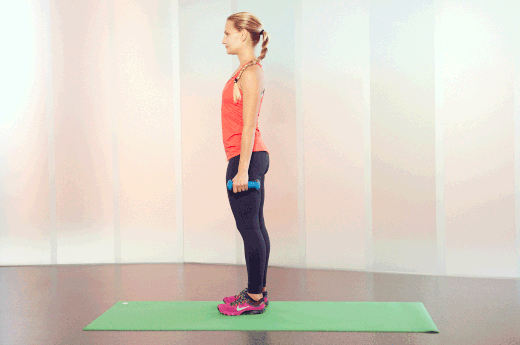
Before jumping into a HIIT routine (literally and figuratively), warming up is essential to prepare your muscles for the workout and prevent injury. For this workout, start with marching. You can also add hand weights to increase the intensity slightly (otherwise go weight-free). Be sure to wear supportive shoes. HOW TO DO IT: March in place, swinging your bent arms as you do so. Move with precision and control at a moderately fast pace (even though it’s a warm-up, it’s not a casual stroll). Do this for 90 seconds. “Whenever bending the knees, point the bent knee toward the second toe to safeguard against future knee pain,” says Los Angeles-based personal trainer Michael Mills.
Warm-Up: Knee Lifts

The knee-lift warm-up is similar to marching in place, but much bigger and a little slower. HOW TO DO THEM: Standing up straight, contract your abdominals and begin your knee lifts in place, imagining you are stepping up onto a step. Alternate legs as your bent arms move naturally. Continue this, lengthening your breathing as you go, focusing on core strength, the control of your limbs and moving with precision and balance for 90 seconds before moving to the next warm-up exercise.
Warm-Up: Heel Taps
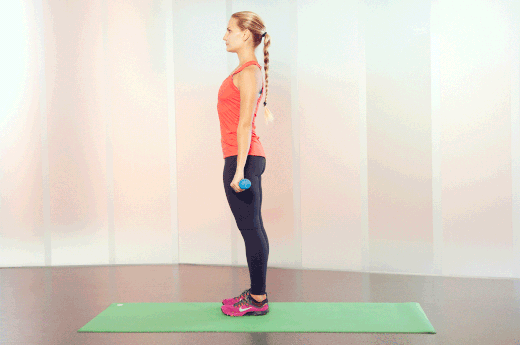
This heel-tap warm-up is straight off an ’80s workout video. HOW TO DO THEM: Stand with your knees slightly bent and feet shoulder-width apart while holding light weights (if desired). Tap your right heel out in front of you while raising your straight arms in the same direction (shoulder height, arms parallel to the floor). If you find yourself hunching over, don’t raise your arms quite as high. Repeat this, alternating heels, for 90 seconds.
Warm-Up: Side-Step Touches
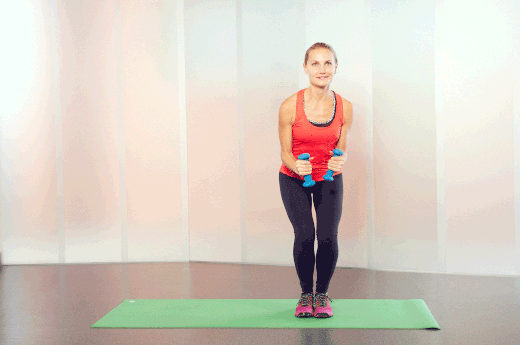
Taking its cues from the classic aerobics move, the side-step touch is a safe way to continue to warm up your muscles and joints for the high-intensity workout to follow. HOW TO DO THEM: Stand with your feet together and arms bent, holding hand weights if you prefer. Engage your core and step your right foot out wide to the right side, then bring the left foot in to meet it. As you step, raise your arms at the elbows in a reverse-fly motion. Next, step your left foot out to the left, then bring your right foot in. Repeat for a full 90 seconds at a rapid pace, maintaining core engagement throughout.
High Knee Lifts With Arm Pull-Downs
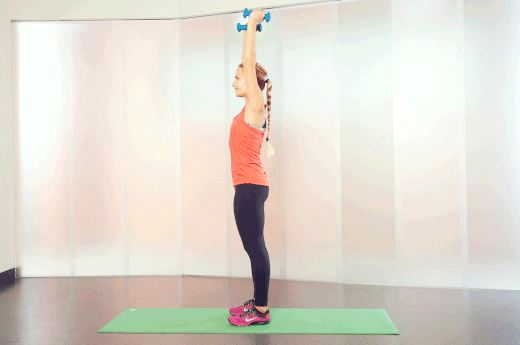
Starting your full HIIT routine with this exercise increases your heart rate and strengthens your quads, abdominals and upper body. HOW TO DO THEM: Starting with your feet hip-distance apart and your arms overhead, contract your abs and draw one knee up to your chest as you pull your elbows down. Return your arms up overhead as you set the lifted foot down and switch sides. Keep your core tight, and don’t turn your feet or knees outward or inward as you move. To add intensity, hold a set of hand weights or a medicine ball.
Standing Side Leg Lifts With Jumping-Jack Arms
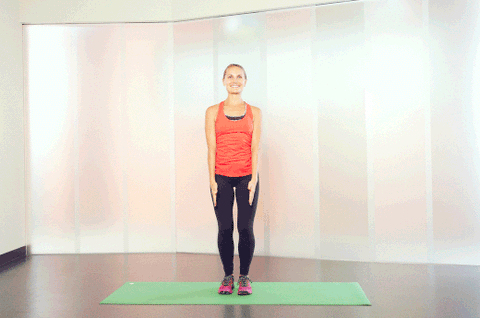
For this exercise, think jumping jacks without the jumping and with one leg at a time. You’ll work the inner and outer thighs, hips, obliques and deltoids. Personal trainer Stephanie Thielen says she likes this exercise for “its ability to strengthen the lateral muscles of the hips, which can help keep the knees aligned and stable.” HOW TO DO THEM: Stand with feet together and arms down along your sides, palms facing your legs. Engage your core, put a very slight bend in the knees, then take both arms overhead until they touch above your head. At the same time, lift the left leg out to the left side. Alternate legs with each arm swing. Contract your abdominals to prevent your hips and torso from swinging with your legs.
Double Side Step With Back Row
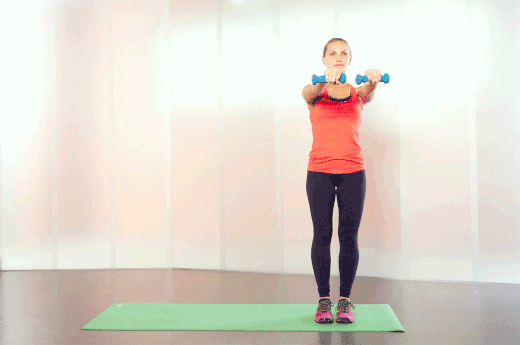
You’ll feel this exercise in your quads, glutes and inner thighs as well as your shoulders, chest and lats. You can choose to do it with or without weights, depending on your fitness level. HOW TO DO THEM: Stand with your arms fully extended in front of your chest. Take two steps to the left, pulling your arms back with each step, and then take two steps with arm rows to the right. Initiate any movement by contracting your abs and pulling through your inner thighs. You can increase the intensity of this move by widening the steps or increasing the pace.
Partial-Squat Heel Jacks

Shape your legs and booty while you burn calories. This exercise concentrates the burn in your glutes and quads and also works your upper body. Personal trainer Stephanie Thielen says: “Sustaining a partial squat helps to improve lower-body endurance and activates the entire lower body while keeping the hips and knees in pain-free range of motion.” HOW TO DO THEM: Stand with your feet together, knees slightly bent, torso tilted forward and arms down at your sides. Open your arms and lift your elbows into a reverse fly and tap the left heel out at a 45-degree angle and bring it back. Do the same with your right foot. Feel free to add hand weights to amp up the intensity.
Repeater Knee Lifts
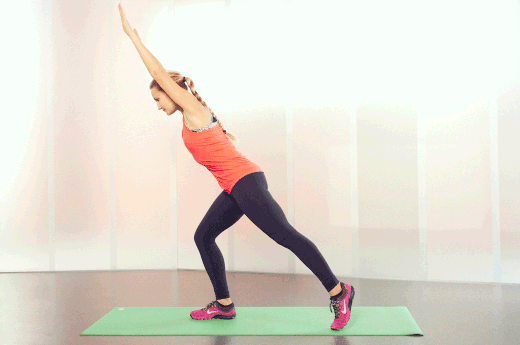
“Repeater knee lifts activate the glutes without requiring you to fully load weight onto the knees,” says personal trainer Stephanie Thielen, “and they’re easy to ramp up. Simply add a medicine ball or small weights, emphasize a higher knee lift or full extension when tapping the foot down in back of you, or just increase the pace of the movement.” HOW TO DO THEM: Start in a split stance -- right foot forward and left foot back. Load about 80 percent of your body weight on the front leg with the front knee slightly bent. Lean your torso forward (in line with your back leg) and extend your arms overhead. Your arms, head, torso and back leg should form a single line. Draw your left knee up and into your chest as your hands come down to tap the knee. Return your arms overhead and the left leg back. Repeat for one full round before switching legs (it will take a total of four minutes to complete this exercise on both sides).
Elevated Squat Thrusts
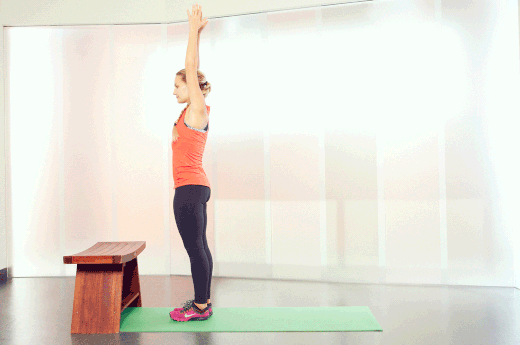
“Elevated squat thrusts will work the glutes, quads, core, shoulders, chest, lats and more,” says personal trainer Stephanie Thielen. “They’re a non-intimidating version of traditional squat thrusts that elevate your heart rate without incorporating deep knee bends to perform the exercise.” HOW TO DO THEM: Stand with your feet together in front of an elevated surface, such as a step, bench or chair. Contract your abs, bend your knees and place your hands on top of the step. Walk your feet back into a high-plank position. Walk the feet back and return to standing, raise your arms overhead and bring them down for one full rep. If your knees can stand doing so, try hopping the feet back and forth, instead of walking them.
March Out-N-Ins

“This exercise will develop speed, agility, endurance and leg strength,” says personal trainer Stephanie Thielen. HOW TO DO THEM: Stand with your feet hip-distance apart and arms bent at 90 degrees. Leading with the right foot, march your feet out wide to the sides then back to the center, pumping your bent arms as you go. Move with precision and control, especially as you go into full effort. Do a full HIIT set leading with the right leg then repeat the round leading with the left leg.
Inchworm Push-Ups
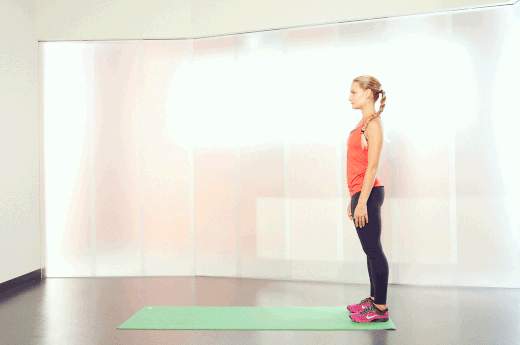
Inchworm push-ups strengthen your shoulders, biceps, lats and chest. HOW TO DO THEM: Stand with your feet hip-width apart and your arms at your sides. Bend at the waist and place your hands on the floor. Walk your hands out until you are in a full plank before doing a push-up. Walk your hands back to your feet, using your abdominal muscles to lift your hips up toward the ceiling. Engage your back muscles to come back to standing. To modify this exercise, come down to the knees when in your plank. Place a cushion underneath if necessary.
Stationary Speed Skaters
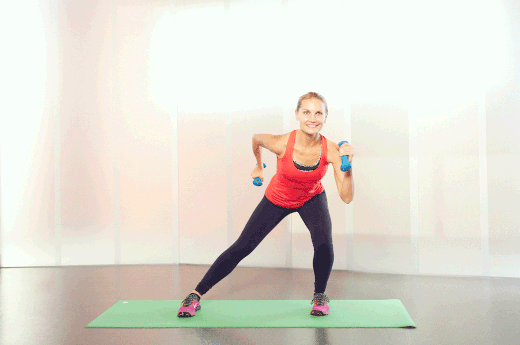
Channel your best Olympic speed skater with this exercise to intensify your workout, get your heart rate up and engage several major muscle groups simultaneously. And with the stationary version, you eliminate the impact on your ankles, knees and hips. HOW TO DO THEM: Stand with your feet wider than hip width. Keeping your feet planted, lean the torso to the right, bending your right knee into a partial side lunge and keeping your left leg straight. At the same time, drive the left arm forward and the right arm back. Shift your weight to the other side, coming into a partial side lunge on the left and straightening the right leg. The right arm will drive forward as the left arm goes back. You can add hand weights, widen your stance more, deepen the lunge or push off from your straight leg to amp up the intensity.
Windmill Steps

Windmills work your entire body, including the arms, glutes and quads. Because of the broad-stroke movement required in windmills, it’s absolutely essential that the core is engaged. HOW TO DO THEM: Stand with your feet together and arms angled toward the left hip. Moving with precision and control, circle your arms up and overhead from the left to the right as you take the left leg back and behind the right leg into a curtsy. Reverse the windmill to the other side. Too easy? Try holding a medicine ball or hand weights as you do your windmills.
Reverse Leg Lifts
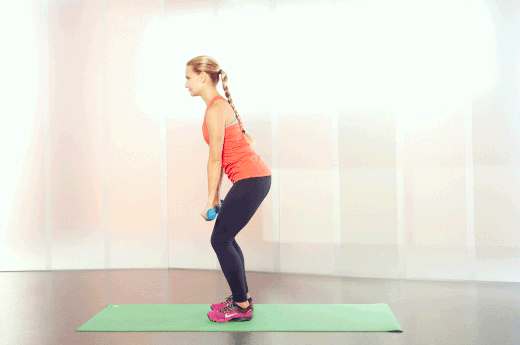
These reverse leg lifts target your glutes and hamstrings like no other. HOW TO DO THEM: Stand with your feet together and knees slightly bent. Lean forward a bit with your weight evenly distributed across each foot from side to side. Take your arms up overhead as you extend and lift the right leg back behind you. Return the right foot to the floor and switch legs. Keep your head and neck in line with your spine and your abs contracted to protect your lower back as you do this exercise. To add intensity, hold a medicine ball or hand weights.
One Final Word

For those with knee, hip or low-back injuries, Walker Ozar, D.C., of Beverly Hills Posture in Los Angeles, recommends balancing out every quad exercise you perform with exercises for your glutes and hamstrings. “The hip flexors are usually already overdeveloped in people from doing cardio and sitting at a desk all day. Overdeveloped hip flexors and quads with weaker glutes and hamstrings can lead to severe low-back pain.” Know your body. Pay attention to signs that may point to possible injury and adjust your workout accordingly.
What Do YOU Think?

Do you love HIIT workouts? What moves are your favorite? Did we miss any great exercises that raise your heart rate while keeping your knees safe? How do you work out around potentially weak or vulnerable joints? Tell us your stories and give us your recommendations in the comments below!
Related:
8 Mistakes To Correct - When You Are Treating Knee Pain At Home
- Choosing a selection results in a full page refresh.

4 comments
Sue Kurczewski
Thanks! My bum knee will appreciate most of these routines (not the last two, however, where one has to fold and bend back on it!
April DeAnna McGowan
Getting old is not for sissies! My knees and back, elbows, and fingers are all creaking. I’ll give it a try but don’t promise I’ll make it through
Kelly A Mueller Romanishan
I thank you too Lisa for this workout. I am overweight and before I started this 35 minute workout,
I couldn’t jump, run or walk upstairs. I use to lose my balance all the time and fell often. I now have better balance, I can do the whole routine and I have more energy during the day. Thanks again.
Jeremy Bamberger
I loved this! Even with my knees that like to bark at me, I was able to do most of these exercises while working up a good sweat. I just had to skip the elevated squat thrusts to protect my knees. Thanks for this!